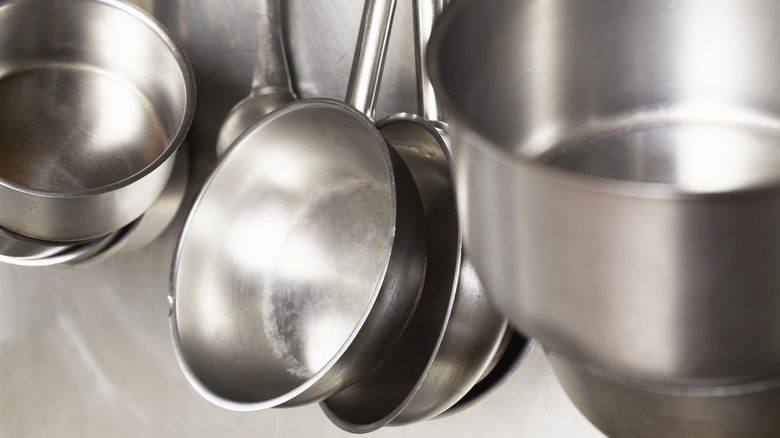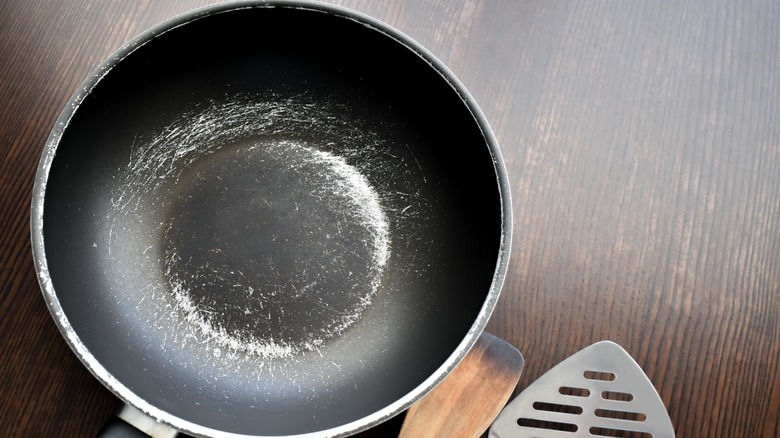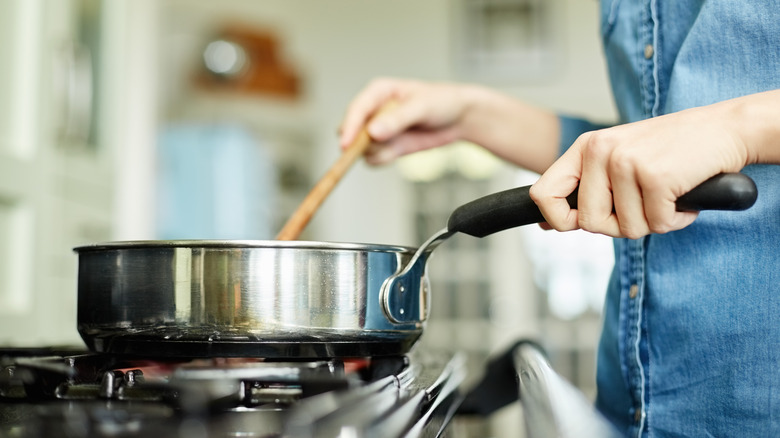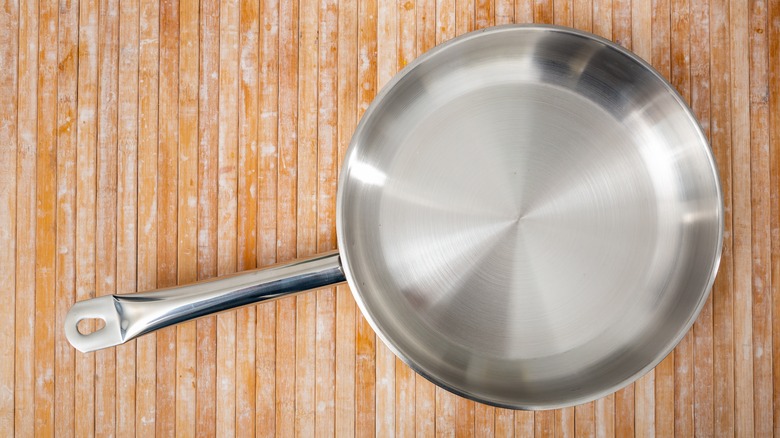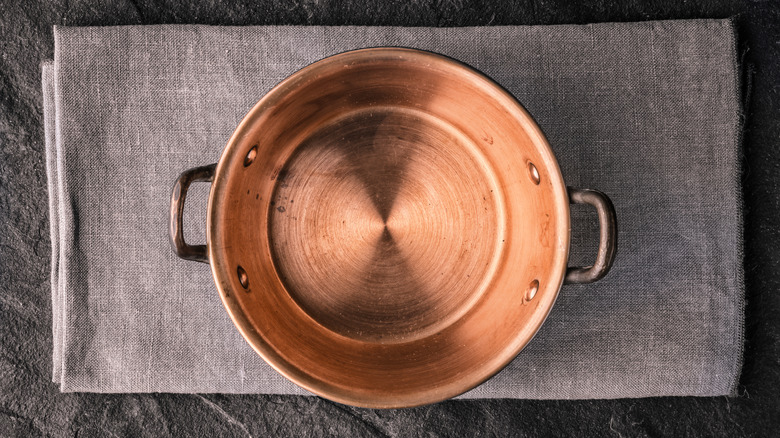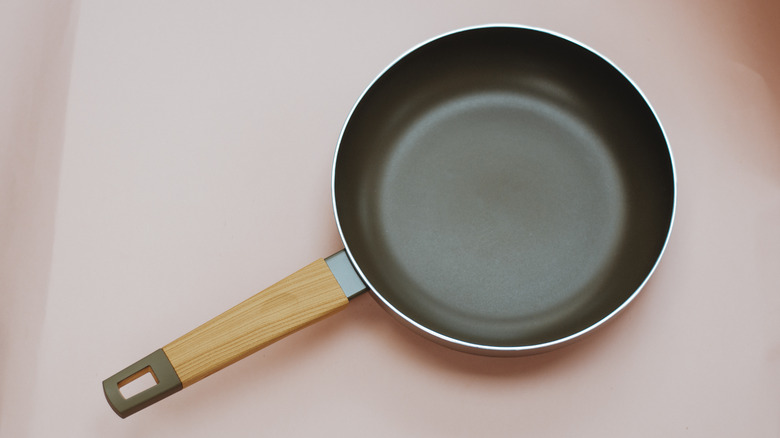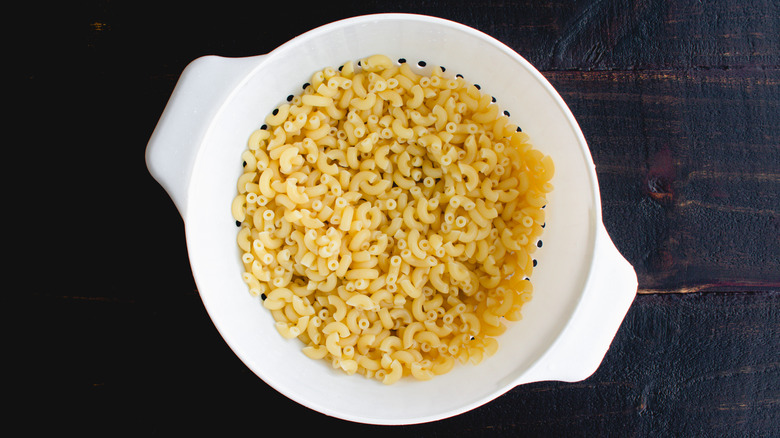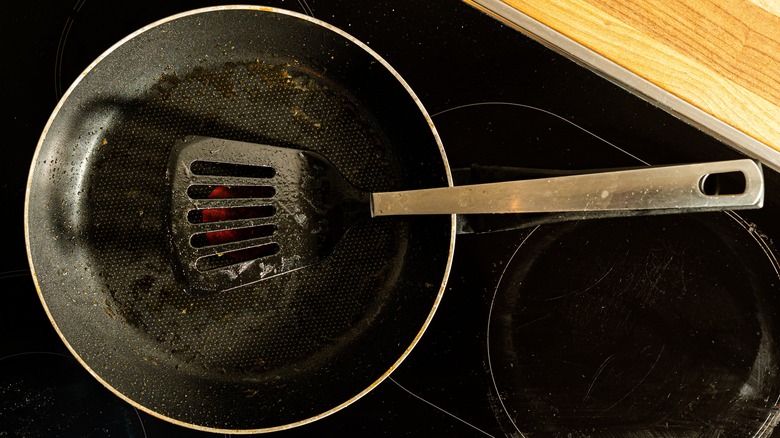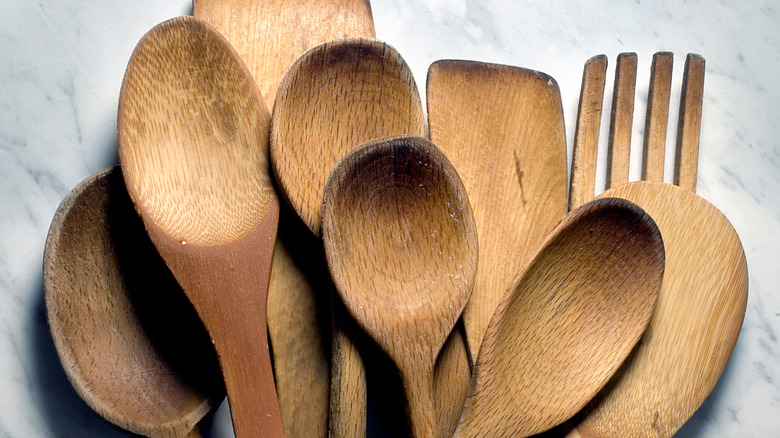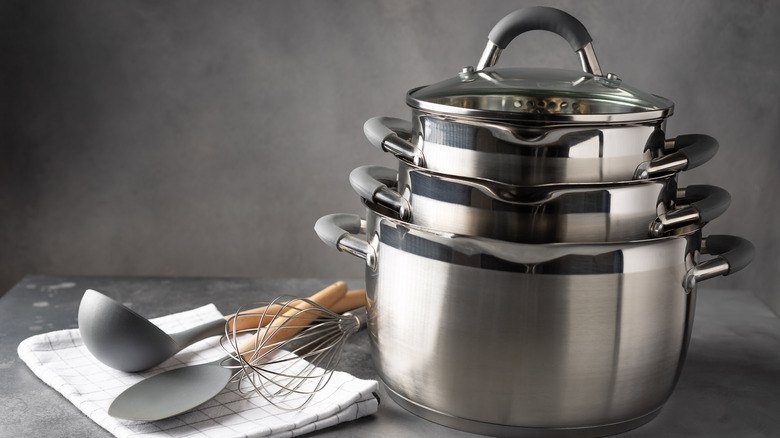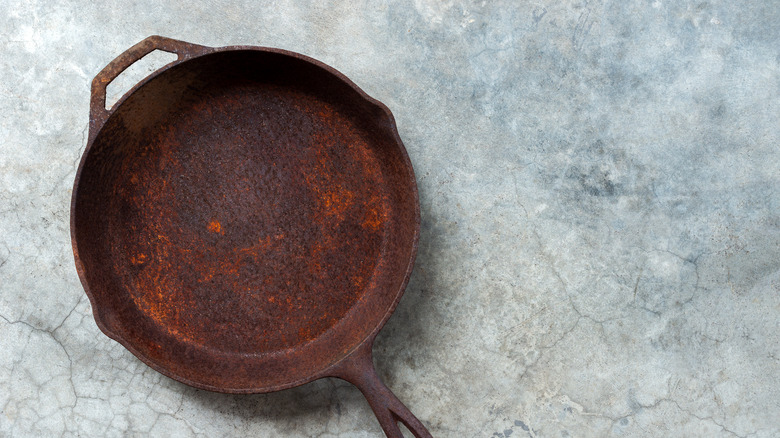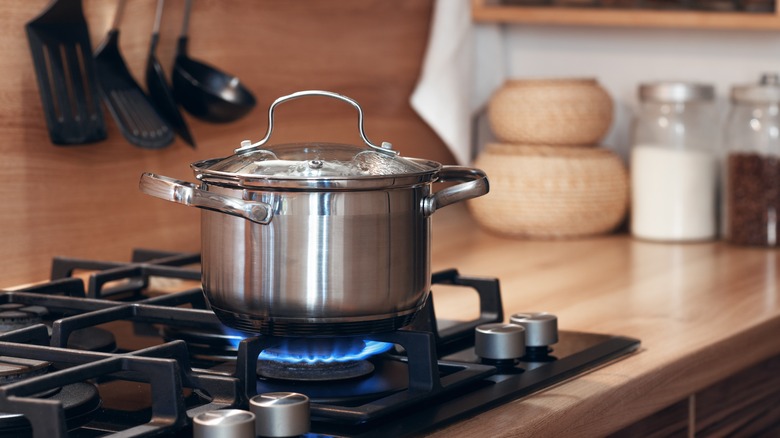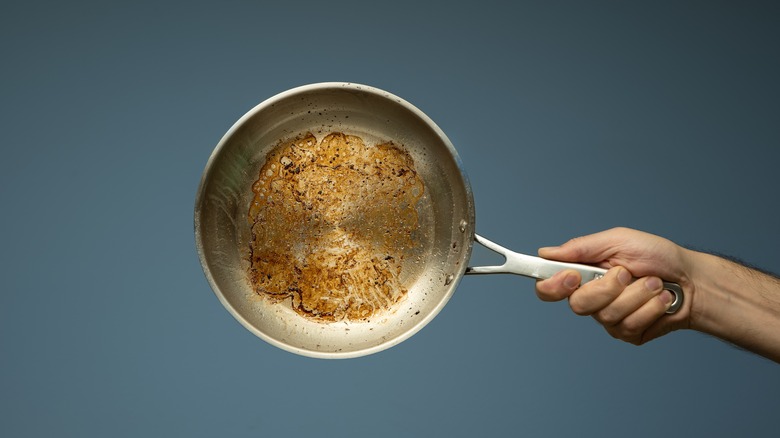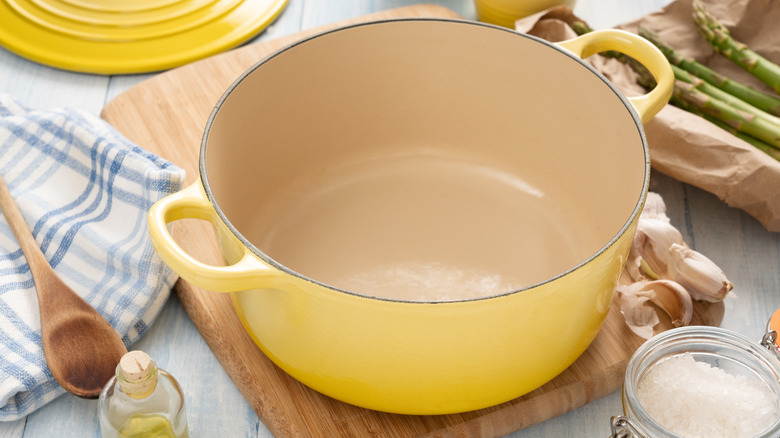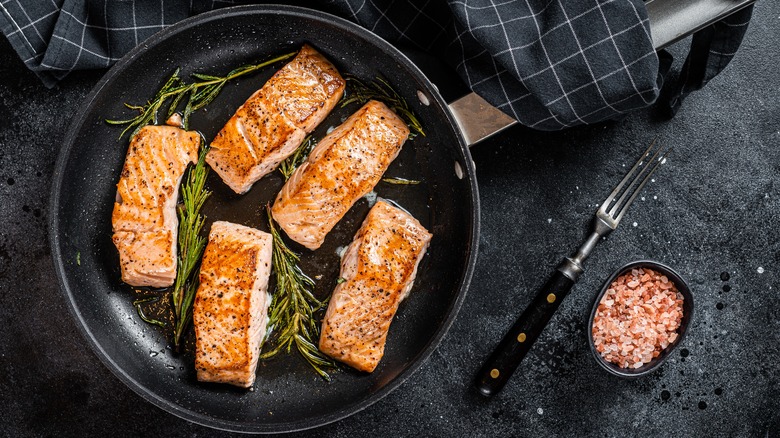14 Signs That It's Time To Stop Using Your Cookware
There's just something about having good cookware, isn't there? Whether you're working with a sauté pan, a frying pan, a stock pot, or any of the other essential pots and pans in your kitchen, everyone wants their cookware to be the best version it can be. This isn't just so you can show off to your friends, either. Buying high-quality cookware will give you a better result overall, with build quality and lifespan ensuring that your food stays delicious time and time again. However, everything has a shelf life, and cookware's no different. As a collection of objects that are used pretty rigorously each day, cookware can deteriorate faster than you think, and when it does, it can start to give off some telltale signs.
Cookware can begin to flag that it's past its prime in some pretty obvious ways, with chipping, flaking, scratching, and rusting all being key signs that you should replace your items. Other signs, however, are more subtle. Your pans may have gently warped (not enough to notice it immediately, but enough to ruin the meal you're making), or they may have a slight greasiness that you can't chalk up to the addition of cooking oil. Whatever the sign, we've got it covered and included in this article.
1. Your non-stick coating is peeling
It's probably no surprise that your non-stick coating peeling off is a sign that you should stop using your cookware, but you'd be amazed how many people ignore it. Non-stick coatings tend to peel off cookware pretty gradually, and at first it can be hard to notice it's happening. This leads to people cooking on flaking cookware for way longer than they should. The problem with a peeling non-stick coating isn't necessarily that it'll harm you — Teflon coating isn't detrimental to health, and if you consume it, it'll simply pass through your digestive system. It's more the fact that it's gross. When your pans start peeling, you can end up with chunks of coating in your food, which will just ruin your dinner and put your friends off coming over for life.
If you don't actively see the chunks of Teflon in your food, you can usually tell your pan's flaking by any exposed metal. This can also cause your food to catch on the bottom. Scratched pans can be more prone to peeling, as you've already damaged the seal in the non-stick coating — so if you've scarred your pans somehow, you may be just one step away from them flaking apart.
2. Your pan handles are loose
Most pan handles loosen over time, and it can sometimes happen way more quickly than you think. If you're a particularly vigorous chef, are using pans that don't have an especially good build quality, or are storing them in an area where they get knocked around, your pan handles can start to pull away from the pan — and that's a problem. Loose pan handles present a massive safety hazard. Not only do you no longer have full control over the boiling pot in front of you, but you run the risk of them detaching, which could result in serious injuries or spilled food all over your floor.
Loose handles can also create gaps in your pot that allow steam to escape, which may alter the quality of the meal you're making and how long it cooks for. Plus, this steam could also lead to nasty burns or scorches on your hands, when you grip the handle to move the pan. In some cases, you might be able to reattach the pan handle yourself. However, it's usually just easier to replace your cookware entirely, so you know it's safe to use.
3. Your stainless steel cookware's core is exposed
Stainless steel pans are super reliable, durable, easy to clean, and capable of cooking up a delicious meal. However, they don't last forever. A key sign that it's time to throw out your stainless steel pans and start afresh is if their core is exposed. Fully clad stainless steel pans are made of two different metals: An outer layer of steel, and an inner layer of aluminum. This aluminum helps it conduct heat effectively and improves its lifespan, but it can also become exposed over time, which ruins the cooking of your food. As well as this, it can cause metal to leach into whatever you're making.
If you're careful with your aluminum pans, it'll take a while for their cores to be exposed. It's when you start to scratch them that things really go wrong. When you're rough with your pans and scratch the stainless steel surface, you end up wearing it away, giving the aluminum underneath the opportunity to poke through. Once you notice that your stainless steel pans show signs of wear and tear, it's time to throw them out.
4. Your copper cookware has scratched
Copper cookware has a lot of benefits. Aside from looking classy and impressive, copper pans have excellent heat distribution, stopping them from having cold spots and ensuring that your food cooks evenly. Unfortunately, like any material, copper can be prone to scratching, and when it happens it's not just a cosmetic issue. Lined copper cookware has an outer coating of a different metal and a copper interior. This outer coating is designed to stop copper leaching into your food, but when it gets scratched, that can quickly happen.
This can create some big issues. Over time, this may lead to copper toxicity, which can produce some unpleasant symptoms like anemia, diarrhea, jaundice, and organ damage (per Mount Sinai). Copper toxicity can also occur from cooking acidic foods in unlined copper cookware, as research from StatPearls discusses, due to the fact that acidic food can degrade copper more quickly. As such, if you notice that your copper cookware is damaged in any way, you should stop using it immediately.
5. Your pans have warped
When you buy your pans, they might be as flat as a pancake on the bottom and perfectly rounded on the sides — but don't expect that to last forever. While the time it can take for pans to warp varies, over time most pans will begin to subtly change shape if you're cooking with them over high heat. This is more likely to happen if your pan is thinner or made of weaker material like aluminum. Rapid temperature changes can also cause your pan to twist out of shape more quickly, with submerging a hot pan in a cold sink being a common cause.
If your pan has only gently warped, it might be okay to use for a while — but in our opinion, once they start to change shape, you should stop using them and replace them as quickly as possible. Warped pans can distribute heat poorly, and may not sit flush on your stovetop, which can create heating issues with electric and conduction stoves in particular. To test whether your pan has warped, simply put it on your counter. If it rocks or wobbles, it's a surefire sign that the bottom has bent out of shape.
6. Your plastic cookware has warped
You may not be cooking with plastic pots and pans, but we can pretty much guarantee that you're using plastic somewhere else in your kitchen. Whether you're draining pasta with a plastic strainer, steaming vegetables using a plastic steamer, stirring sauces with plastic utensils, or microwaving leftovers with plastic Tupperware — it's everywhere, y'all. The problem is that plastic can warp at a way lower temperature than metal, and once it does, it's pretty much useless. Although many plastic kitchen items are built to withstand heat, it's all too easy to hit them with a little too much, warping them beyond recognition.
Once this happens, your plastic cookware can become misshapen and more difficult to use. Warped Tupperware, for instance, may alter its shape so much that you can no longer get the lid on it. Plastic utensils, meanwhile, can lose their ability to scoop, flip, or stir food properly. It's worth remembering that plastic can warp in some unexpected places: Particularly thin or pliable plastic items may warp in your dishwasher, for example. The good news is that plastic cookware is relatively inexpensive, so it shouldn't be too challenging to replace.
7. Your cookware looks greasy
Is your cookware starting to look a little sticky and shiny, even once you've cleaned it thoroughly? It could be time to retire those pots and pans and go for new ones. "Cookware can develop a film or greasy appearance that can not be cleaned after multiple attempts," says Blue Monkey Catering owner and chef Scott Clarke over at Southern Living. "This will impact the quality, consistency, and taste of the finished food product."
Naturally, this is more likely to happen if you're not cleaning your pans properly. If you're not thorough about scrubbing them after use, they can build up a stubborn layer of grease that's impossible to shift. It's also worth remembering that, in some cases, a gentle layer of fat on your pans can be a good thing, like in the case of a well-seasoned wok (although it's worth learning to tell the difference between a seasoned wok and one that needs cleaning). If you think your pan might be salvageable but just needs a deep clean, you may be able to shift the burnt grease by simmering a combination of baking soda and water in it for about 20 minutes, and then scrubbing it thoroughly. If that doesn't do the trick, it's best to stop using it.
8. Your wooden cookware has lingering odors
Wooden cookware is pretty much always in vogue, and we can see why. Affordable, environmentally friendly, and with a versatile aesthetic that fits into any kitchen, most people have at least a few wooden cooking implements in their homes. Unfortunately, they have one major downside: They're pretty prone to soaking up food odors. This is especially likely to happen if you're using them to cook strong-smelling foods like onions, garlic, and heavily-spiced broths or curries — and these odors can then go on to both cause a stink in your cupboards and drawers and potentially flavor your next meal.
Food odors are absorbed by wooden spoons because of the porous nature of the wood, which soaks up smells far more easily than metal or plastic. There are methods to reduce smells absorbed by wooden cookware, and if your items are relatively new, they could be worth a shot. Try rubbing your wooden spoons and cutting boards with a little baking soda and water, leaving them for a while so that the odors can neutralize. It can also be a good idea to keep certain wooden items solely for your strong-smelling foods, and others for milder-smelling ones.
9. Your cookware no longer suits your purposes
We all outgrow things as time goes on, and that's as true for your cookware as it is for other things in life. That cookware set that you bought and loved a few years ago may simply no longer be suitable for your purposes. Your kids may have grown into eating the same meals as you, meaning that small crockpot needs to be replaced by a big one so that you can make more portions. They may have grown so much that they've moved out of the house, and your big soup pans are just taking up too much space. Or you may simply want a refresh, and are in the market for a cookware set that matches the aesthetic of your newly-decorated kitchen.
Whatever the reason, there's no shame in recognizing that we don't need to keep the same cookware forever. Using a pan that's too big or too small can lead to clumsily-made dishes that aren't cooked as well as they could be. Don't be tempted to just throw it in the trash, though. If your cookware is still functional, consider donating it or giving it to a family friend, so another person can get some use out of it.
10. Your pans have developed rust
Pots and pans are the workhorses of our kitchen, y'all. They're constantly coming into contact with different textures and ingredients, and get way wetter than most of the other objects and utensils we use while cooking. This doesn't just happen when we're making food with them, either: Washing our metal cookware requires a lot of water, and if you don't dry it properly afterward, it can cause pans to rust. Rusting can also occur more quickly if you're leaving your pans to soak or putting them in the dishwasher. Iron and stainless steel pans can be prone to rusting, leaving your food tasting horrible, while other pans that have iron elements (like copper pans with iron handles) can also be at risk.
If your pan is relatively new and you don't want to throw it out, it may still be salvageable. Applying a combo of baking soda and vinegar to your rusty spots and leaving it to soak for a few minutes before scrubbing it off may help to shift smaller rust marks. If your items are especially rusty, though, you should get rid of them immediately. You should also make sure you're practicing proper aftercare with your pans once you've finished cooking, cleaning and drying them thoroughly and storing them in a moisture-free environment.
11. Your cookware is taking longer to heat up
If your meal is taking a little longer than it normally does, it may not be just because you're moving more slowly than usual. It could well be because your pans are beginning to deteriorate. You may not think so, but pots and pans can decline in performance over time, meaning that they can take longer to heat up — which may unnecessarily prolong your cooking session. They can also become less responsive to you flicking the heat up or turning it down.
This sounds like a minor problem, but it really isn't. If your recipe requires a two-step process, with the second part requiring more heat rapidly, then this lack of responsiveness can pretty much ruin your meal. On the other hand, if you need to quickly drop the temperature of your pan and find that the heat's taking too long to dissipate, this might leave you overcooking your food. While this can be pretty difficult to spot, if you're noticing that they're not performing as well as they should be, you might want to replace your pots and pans with some new ones.
12. Your pan's bottom is seriously scorched
Look, we're all human. We've all flung the temperature just a touch too high on our pans, only to find that our food is sticking to the bottom or that it's developed some delightful-looking black scorch spots on the surface. Unfortunately, this is a common problem with stainless steel pans, thanks to their super-conductive aluminum core. That aluminum raises the temperature of the pan incredibly quickly, leaving us with burn marks on the bottom that are a nightmare to shift.
If this happens to you, it may be worth remembering that you might be able to save the pan before throwing it out. Acids like lime juice and vinegar (and even tomato sauce) can help to shift stubborn scorch marks, while baking soda and cream of tartar are also pretty good at lifting black spots. However, there are times when, try as you might, those scorched spots can't be lifted. When this happens, you should stop using your cookware immediately and get a new pan. Don't be tempted to just ignore it and keep cooking with the scorched pan, either: You'll quickly find that your food tastes burnt, bitter, and just plain gross.
13. Your cookware is more than a few years old
Okay, so this one comes with a caveat: We're not telling you that you should throw out any pan that's over five years old. We know that there are plenty of examples of woks and cast-iron pans being passed down through generations, and still being totally capable of making delicious meals. However, as a rule of thumb, many pots and pans will start to deteriorate after a few years of constant use, and once you hit the five-year mark it could be worth considering a refresh.
This is going to be most noticeable with nonstick cookware, which has a roughly five-year lifespan. After this, you'll probably see that it significantly loses its ability to stop your food from sticking, and you'll be scraping a lot of meals off the bottom. You may also find that your nonstick coating starts to flake or peel away. Some pans may have an even shorter window before they start to deteriorate: Ceramic pans, which can be confusing to clean correctly, may only last a year or two before you have to throw them out. Crucially, though, every pan is different, and you'll likely have an instinctive sense of when yours needs to be replaced. Plus, you should always practice good care with your pans, following the manufacturer's instructions for cleaning and storing them to prolong their lifespan.
14. Your food sticks to your pans
It probably doesn't take a genius to realize this, but the moment that your nonstick pans stop being, well, nonstick, it's time to throw them out. Nonstick pans degrade for several reasons, with age and frequent use contributing to them becoming worn out. However, if you're rough with your pan or use the wrong utensils, you can find that the coating deteriorates — and your pan-seared salmon and juicy steaks will start to catch on the bottom.
Food can also start to stick on your pans if you're not cleaning them properly, leaving food residue that then increases the likelihood that later food will stick. Cleaning this off, however, can also cause issues: When you scrub your pans too thoroughly, you may end up scraping off their nonstick coating. Whatever the reason, if you find that your food is sticking, it's probably time to consider trading in your pans for a new set.
